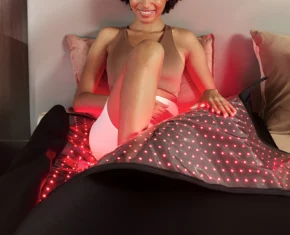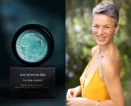Yesterday, we spent some time with world-renown yogi Elena Brower before she jets off to the biggest yoga festival of the year, Wanderlust, next week. And today, we’re living that yogi live vicariously via the most gorgeous yoga book we’ve seen – maybe ever. Wanderlust: A Modern Yogi’s Guide To Discovering Your Best Self is the perfect fusion of a guide to asana, yogi lifestyle, and mind-body wisdom, with a through-line focus of “finding your true north” and the journey of self-actualization.
Filled with all kinds of gems – from ways to build your own asana practice to unleash your inner artist – we kept coming back to the part about chakras. Unlike most run-downs, healer Thomas Droge not only talks about each chakra, but how to balance them and tap into each one through yoga poses. Roll out your mat, light a candle, and balance your chakras…
In the spiritual traditions of India, the body is viewed in both its physical and its energetic form. This energetic form is known as the “subtle body.” Within the subtle body we find chakras. These are meeting points of the energetic pathways of the body known as the nadiis. Prana (our life force) uses these pathways to travel throughout the body.
The seven main chakras span the area from the base of the tailbone at the pelvic floor to the top of the head. Each corresponds to a different physical and spiritual developmental state, with a unique connection to particular organs, emotional and spiritual issues, physical ailments, colors, and sounds.
Chakras can be accessed by asana, meditation, breathing, environment, and touch. As we look at each individual chakra, you will see how we can activate and transform our issues at the physical or psychological level through the spiritual asana practice of opening and activating our chakras:
THE FIRST CHAKRA:
Muladhara: Mula (root) adhara (support) – Located at the tip of the coccyx and the pelvic floor, this chakra is associated with physical identity, survival, stability, and instinctual nature. Psychologically it relates to fear, ungroundedness, and anger. Physically it corresponds to tiredness, poor sleep, lower-back pain, immune disorders, and obesity.
To strengthen muladhara, we build strength, physically grounding the body with the stability of the earth so we can be rooted, self-aware, courageous, and fearless.
Asanas: Moutain Pose, Warrior Pose, Standing Forward Bend
THE SECOND CHAKRA
Svadhisthana: Seat of Vital Force – Located between the sacrum and pubic bone, including the genitals, svadhisthana corresponds with the center of gravity of the body. This chakra relates to the cultivation of the emotional and sensual self. It is the home of the reproductive organs, the kidneys, the hips, and the sacrum.
Fluidity, sensual pleasure, and dance, as well as physical and emotional expression, are all rooted in this second chakra. It is psychologically connected to power and control issues, morality, obsession, guilt, blame, and addiction. The power released in the physical world with this chakra is not to be trifled with. This chakra often relates to emotional identity, desire, procreation, self-love (especially physical), and relationships. It relates to health issues associated with libido, sciatica, lower-back pain, vertigo, menstrual issues, and hormonal imbalances.
When balanced, svadhisthana produces a balanced, vital, sexually uninhibited, prosperous, satisfied way of being.
Asanas: Hip openers, Wide-Stance Forward Bend, Wide-Stance Seated Position, Seated Bound Angle Pose
THE THIRD CHAKRA
Manipura: City of Jewels – Located at the solar plexus, manipura is a central point of transformation in the body. In these alchemical practices, when we really want to change, we engender fire (manipura’s element) and burn away our former selves to allow for a new self to emerge. Jewels also function as prisms, bending light to change the look of reality, thereby reminding us that reality is shaped by perception.
Some of the organs associated with manipura include the stomach, liver, gallbladder, midspine, and small intestines. This chakra can help you deal with psychological issues like low self-esteem, timidity, depression, fear of rejection, perfectionism, anger, indecisiveness, and rage.
When manipura is balanced, one feels confident, clear, decisive, productive, and focused, and one’s digestion is excellent.
Asanas: Half-twist, Boat Pose, Backbends, “Breath Of Fire”
THE FOURTH CHAKRA
Anahata – Anahata literally means “unbeaten.” It is the heart chakra and the center point in the chakra system, standing between the three lower earthly chakras and the three celestial chakras above. Through the heart chakra we harmonize heaven and earth, finding the dynamic balance between spiritual practice and living in the earthly realm. It is my belief that this chakra holds the power to transcend pain and suffering.
At the core of this chakra is love, and love is the unifying healing force that links us all together. One of the best ways to strengthen the heart chakra is to offer it openly to the world.
Asanas: Eagle Pose, Cow Pose, Backbends, Chest-opening poses
THE FIFTH CHAKRA
Visuddha: Purification – Unlike the lower chakras, visuddha is focused on the spiritual and metaphysical path. Located at the throat, this chakra connects the spiritual and physical plane through the vibration of sound.
The reading of poems and prayers and chanting are all excellent ways to express the positive nature of this chakra. The throat, thyroid, and parathyroid glands are always associated with visuddha, and they are often healed through communication and creativity.
Asanas: Fish Pose, Lion Pose, Supported Shoulder Stand
THE SIXTH CHAKRA
Ajna: Third Eye – Located between the two eyebrows, ajna is related to inner vision. This chakra sits in the acupuncture point often translated as “calm spirit,” and provides us with the unique gift of being able to link our sight with our crown chakra to access the greater collective consciousness. This is the chakra we use to scan our body and energetic field for disturbances.
This chakra requires rooting in the earth element through the breath in order not to overactivate it. Dysfunction of this chakra can lead to headaches, nightmares, eyestrain, and learning disabilities. When balanced, this chakra produces a deep, clear calm and is capable of creating reality from thought.
Asanas: Breath work, meditation, Child’s Pose, Yoga Nidra
THE SEVENTH CHAKRA
Sahasrara: One-Thousand-Petaled Lotus – The lotus represents the infinite creation and destruction of all things. Located at the crown of the head, sahasrara allows you to directly receive celestial information and to connect with deities and other energy forces available to you.
This chakra, when open, can collapse time and space and allow the future and past to be available to you simultaneously. Often misinterpreted as seeing the future, a deep connection with sahasrara allows you to see everything in the now.
Asanas: Tree Pose, Eagle Pose, Seated Meditation
Reprinted from Wanderlust by Jeff Krasno. Copyright (c) 2015 by Jeff Krasno. By permission of Rodale Books. Available wherever books are sold.











